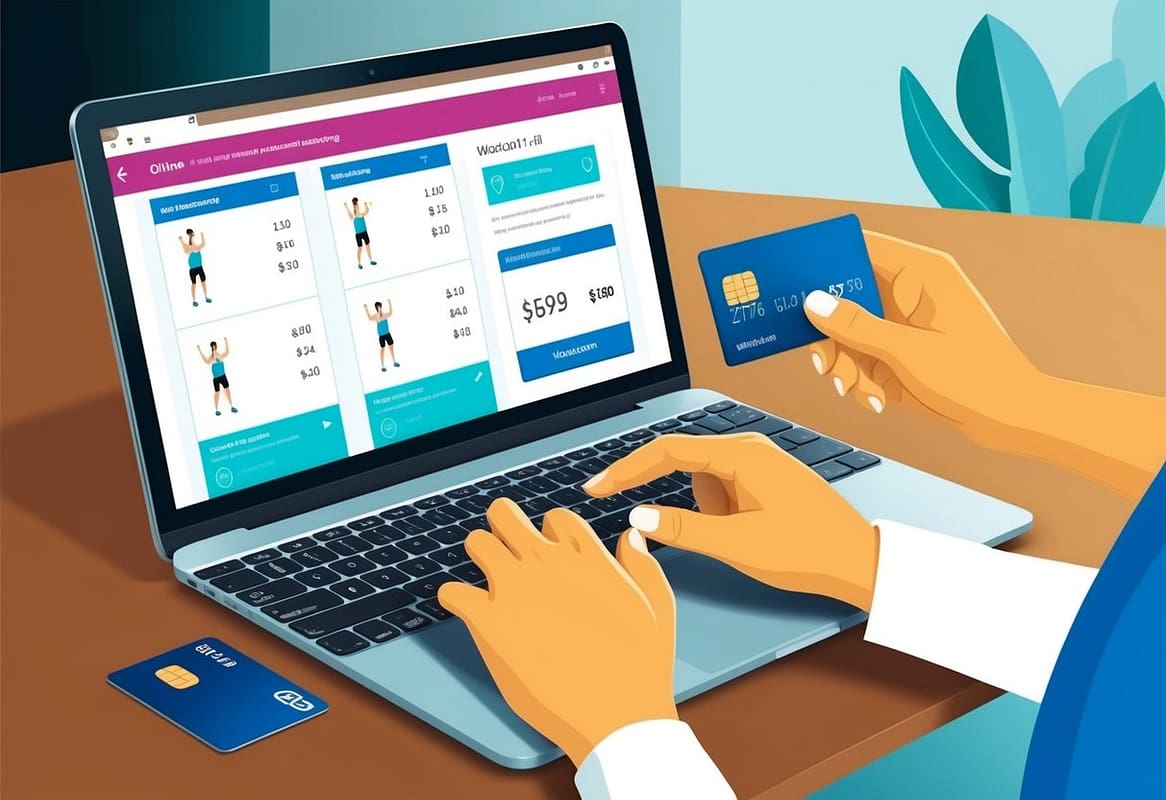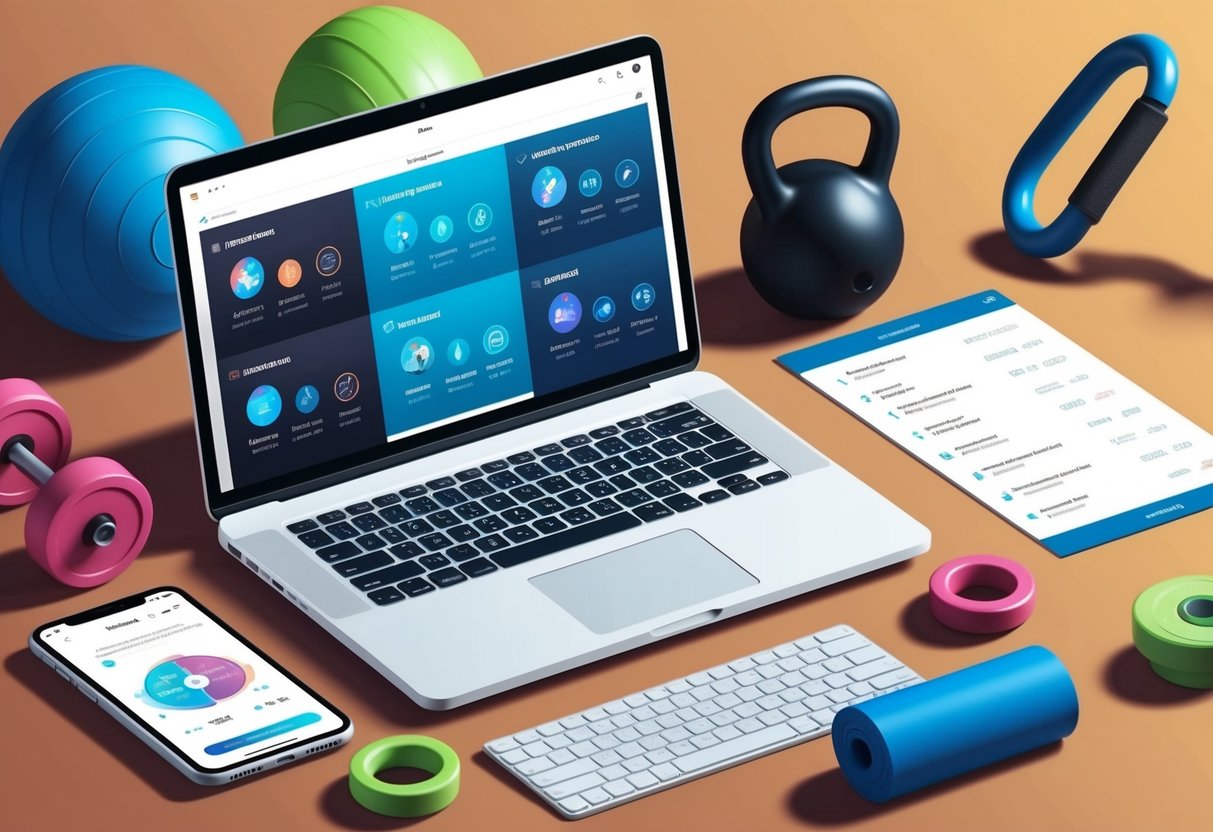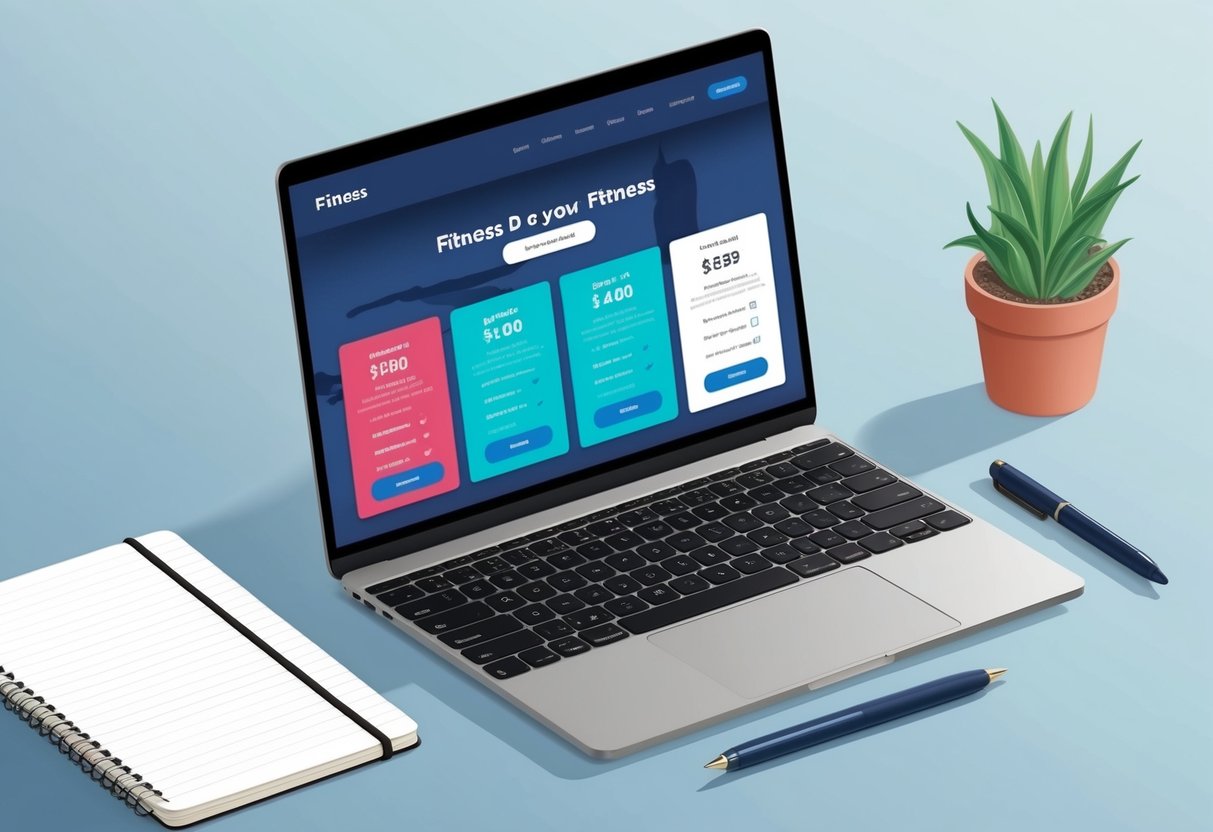Online personal training has revolutionized the fitness industry. It offers personalized workouts and nutrition plans from the comfort of your home.
This flexible approach to fitness has gained popularity, especially in recent years. But how much does it actually cost?

The price of online personal training typically ranges from $50 to $300 per month. This depends on factors such as trainer experience, program customization, and frequency of interaction.
Some trainers offer weekly or per-session rates, which can vary from $30 to $100 per session. These costs often include personalized workout plans, nutritional guidance, and regular check-ins.
Popular Posts
- Massage Gun vs. Foam Roller: Which Recovery Tool Reigns Supreme?
- 27 Best Calisthenics Exercises for Full-Body Strength and Fitness
- 10 HIIT Workouts for Busy Professionals: Max Fitness, Min Time
- Good Posture Working from Home: Optimize Your Workspace to Prevent Discomfort and Health Issues
- The Best Crossfit Exercises for Full-Body Conditioning
When considering online personal training, it’s important to weigh the benefits against the costs.
You’ll have access to expert guidance, tailored programs, and ongoing support without the need to commute to a gym. This convenience can lead to better consistency and results in your fitness journey.
Key Takeaways
- Online personal training costs vary based on trainer expertise and service level
- Personalized programs and remote accessibility are key benefits of online training
- Comparing different trainers and packages can help you find the best value for your goals
Understanding Online Personal Training
Online personal training provides customized fitness guidance through digital platforms. It offers flexibility and personalized coaching without the need for in-person sessions.
What Online Personal Training Encompasses
Online personal training involves virtual interactions between you and a fitness coach. You receive tailored workout plans, nutrition advice, and progress tracking through apps or websites.
Your trainer assesses your goals, fitness level, and available equipment to create a program suited to your needs.
These programs often include video demonstrations, real-time feedback, and regular check-ins. You can access your workouts anytime, anywhere, making it easier to fit exercise into your schedule.
Benefits of Choosing Online Personal Training
Online training offers convenience and affordability compared to traditional gym sessions. You can work out at home or outdoors, saving time and travel costs.
Programs are often more budget-friendly, as trainers can work with multiple clients simultaneously.
You’ll have continuous support through messaging systems or scheduled video calls. This ongoing communication helps maintain motivation and accountability.
Online platforms also provide easy tracking of your progress, allowing for quick adjustments to your plan as needed.
Key Components of Online Training Programs
Effective online training programs include detailed workout plans tailored to your goals. These plans often feature exercise libraries with video tutorials to ensure proper form.
You’ll receive nutrition coaching to complement your fitness routine, with meal plans or general dietary guidelines.
Regular assessments help track your progress and refine your program. Many platforms offer community features, connecting you with other clients for added motivation.
Mobile apps allow you to log workouts, track nutrition, and communicate with your coach on the go.
Personalized coaching remains central, with trainers providing feedback and adjustments based on your progress and feedback.
Determining Your Fitness Objectives
Setting clear fitness goals and understanding your current abilities are crucial steps in creating an effective online personal training plan. A tailored approach ensures you make progress and stay motivated throughout your fitness journey.
Setting Realistic Goals
Define specific, measurable targets for your fitness journey. Do you want to lose weight, build muscle, or improve endurance?
Aim to lose 1-2 pounds per week for sustainable weight loss. For strength training, set goals like increasing your squat by 20 pounds in 8 weeks.
Break larger objectives into smaller, achievable milestones. This approach helps maintain motivation and track progress.
For example, if your goal is to run a marathon, start with a 5K race, then a 10K, and gradually increase your distance.
Consider your lifestyle and time constraints when setting goals. Be honest about how much time you can dedicate to exercise each week.
Assessment by an Online Fitness Professional
An online trainer will evaluate your current fitness level through questionnaires and video assessments. They’ll ask about your exercise history, any injuries, and daily activity levels.
You may be required to perform specific exercises or movements while recording yourself. This helps the trainer assess your form and identify areas for improvement.
Your trainer will use this information to create a personalized workout plan. They’ll consider your strengths, weaknesses, and any physical limitations to ensure safe and effective training.
Beginner vs Advanced Fitness Strategies
If you’re new to exercise, focus on building a solid foundation. Start with bodyweight exercises and light weights to develop proper form and technique.
Aim for 2-3 full-body workouts per week, gradually increasing intensity and frequency.
For beginners, emphasize consistency over intensity. Establish healthy habits like regular exercise and balanced nutrition.
Set achievable goals like exercising for 30 minutes, three times a week.
Advanced exercisers require more specialized programming. Your online trainer may incorporate periodization, varying workout intensity and volume over time.
They might suggest split routines targeting specific muscle groups on different days.
Experienced fitness enthusiasts often benefit from more frequent training sessions, typically 4-6 per week.
Your trainer may introduce advanced techniques like supersets or drop sets to challenge your muscles and prevent plateaus.
Choosing the Right Online Personal Trainer
Selecting an online personal trainer requires careful consideration of several key factors. Your choice can significantly impact your fitness journey and results.
Factors to Consider
Look for trainers with experience in your specific goals. Whether you aim to lose weight, build muscle, or improve athletic performance, find someone who specializes in that area.
Consider their availability and communication style. Do they offer real-time video sessions or asynchronous messaging? Ensure their schedule aligns with yours.
Evaluate the trainer’s technology and platforms. Do they use user-friendly apps or websites?
Check if they provide workout tracking, progress monitoring, and nutrition guidance tools. These features can enhance your training experience and help you stay on track.
Price is another crucial factor. Compare rates and package options among different trainers.
Remember, the most expensive isn’t always the best fit for you. Look for value in terms of services offered and results achieved by their clients.
Certifications and Specializations
Verify your potential trainer’s credentials. Look for certifications from reputable organizations like NASM, ACE, or ISSA. These ensure the trainer has a solid foundation in exercise science and safety.
Consider trainers with additional specializations relevant to your needs. For example, if you have a medical condition, seek someone with experience in that area.
Specializations in nutrition, corrective exercise, or sports performance can provide added value.
Don’t hesitate to ask about their ongoing education. The best online personal trainers stay updated with the latest fitness research and techniques.
This commitment to learning ensures you receive cutting-edge, effective training.
Reviewing Trainer Profiles and Testimonials
Examine trainer profiles thoroughly. Look for clear information about their background, philosophy, and training style.
Photos or videos of the trainer demonstrating exercises can give you insight into their expertise and professionalism.
Read client testimonials and reviews. These provide real-world feedback on the trainer’s effectiveness and client satisfaction.
Look for reviews that mention specific results or positive experiences related to your goals.
Many trainers offer free consultations or trial sessions. Take advantage of these opportunities to assess their communication style and see if you feel comfortable working with them.
This personal interaction can be crucial in finding the right fit for your fitness journey.
Comparing Cost Structures
Online personal training offers various pricing models and options to fit different budgets and fitness goals. The cost structures can vary significantly based on factors like session type, frequency, and payment plans.
Understanding the Pricing Models
Personal trainers typically charge by the hour or session. Rates can range from $30 to $100+ per hour, depending on the trainer’s experience and reputation.
Some trainers offer package deals, which may reduce the per-session cost. For example, a 10-session package might cost $450, bringing the per-session rate down to $45.
Monthly subscriptions are another popular option. These can range from $100 to $300 per month, often including a set number of sessions and additional perks like nutrition plans or app access.
Individual vs Group Session Costs
Individual sessions generally cost more than group sessions. A one-on-one virtual training session might cost $50-$80, while a group session could be priced at $20-$40 per person.
Group personal training offers a more budget-friendly option. You benefit from personalized attention at a fraction of the cost of individual sessions.
Some trainers offer small group sessions for 2-4 people, which can be a good compromise between individual attention and affordability.
Subscription Services vs One-Time Payments
Subscription services often provide better value for long-term commitments. A typical monthly subscription might include 4-8 sessions plus additional resources for $200-$400.
One-time payments are suitable for those who prefer flexibility. You might pay $60-$100 per session without any long-term commitment.
Some trainers offer hybrid models. For instance, you could pay a base monthly fee for access to recorded workouts and nutrition plans, with the option to add live sessions at a discounted rate.
Exploring Types of Training and Services
Online personal training offers diverse options to suit individual fitness goals and preferences. Trainers provide tailored programs and support through digital platforms.
Variety in Workout Programs
Online personal trainers offer a wide range of workout types. You can choose from cardio routines, strength training, bodyweight exercises, or a combination.
Many trainers specialize in specific areas like:
- High-Intensity Interval Training (HIIT)
- Yoga and flexibility
- Weightlifting
- Functional fitness
Your trainer will design a program that aligns with your goals, fitness level, and available equipment.
Some may focus on bodyweight workouts for those without gym access, while others might create plans for full gym setups.
Incorporating Nutrition into Training
Nutrition often plays a crucial role in online personal training services. Many trainers offer:
- Customized meal plans
- Nutritional guidance
- Recipe suggestions
- Macronutrient tracking advice
These services help you fuel your workouts effectively and support your overall fitness goals. Some trainers use apps or software to monitor your food intake and provide real-time feedback on your dietary choices.
Personalization and Adaptability of Workouts
Online personal training excels in customization. Your trainer will:
- Assess your fitness level
- Consider your goals and preferences
- Design workouts tailored to your needs
- Adjust plans based on your progress
Personal training apps often allow trainers to modify your program quickly. They can adapt workouts if you’re traveling, injured, or facing time constraints. This flexibility ensures your fitness journey remains on track despite life’s changes.
Leveraging Technology for Training
Technology has transformed personal training, making it more accessible and effective. Digital tools now allow trainers to deliver customized programs and track client progress remotely.
Utilizing Personal Training Apps
Personal training apps have revolutionized how fitness coaching is delivered. These apps offer various features, such as:
- Workout plans
- Exercise demonstrations
- Progress tracking
You can also access your training program anytime, anywhere.
Many apps use AI to adapt workouts based on your performance and goals. They also include video tutorials to ensure proper form and technique. Some popular features include:
- Customizable workout schedules
- Exercise libraries with instructional videos
- Integration with fitness trackers
- Nutrition tracking and meal planning
These apps can provide a more affordable alternative to in-person sessions while still offering professional guidance.
Online Communication and Check-ins
Virtual personal trainers use various communication tools to stay connected with clients. Regular check-ins help maintain accountability and allow for program adjustments.
Common communication methods include:
- Video calls for form checks and discussions
- Messaging apps for quick questions and updates
- Email for detailed feedback and progress reports
You can often schedule these interactions at times that suit your schedule, making it easier to fit training into your busy life.
Tracking Progress with Digital Tools
Digital tools have made progress tracking more accurate and comprehensive. Fitness trackers and smartwatches can monitor various health metrics, providing valuable data to both you and your trainer.
Key metrics often tracked include:
- Daily step count
- Heart rate during workouts
- Sleep quality and duration
- Calorie expenditure
This data helps trainers adjust your program for optimal results. Many online training platforms also offer dashboards where you can view your progress over time, set goals, and celebrate achievements.
Digital tracking tools can increase your motivation by visualizing improvements and identifying areas for growth. They also allow trainers to provide more personalized advice based on your actual performance data.
Maximizing Success and Accountability
Achieving fitness goals requires commitment, support, and the right tools. Implementing effective strategies can significantly boost your progress and motivation.
Building Self-Discipline
Develop a consistent routine to strengthen your self-discipline. Set specific, achievable goals and create a schedule for your workouts. Start small and gradually increase intensity.
Reward yourself for meeting milestones to reinforce positive habits. Use reminders on your phone or fitness tracker to stay on track.
Visualize your success and remind yourself of your reasons for starting this fitness journey. This mental reinforcement can help you push through challenging moments.
Regular Monitoring and Support
Track your progress using fitness apps or a journal. Record your workouts, measurements, and how you feel after each session.
Schedule regular check-ins with your online personal trainer. These sessions allow you to discuss challenges, celebrate victories, and adjust your program as needed.
Consider joining online fitness communities or finding an accountability partner. Sharing experiences and encouragement can boost your motivation and commitment.
Investing in Necessary Equipment
Identify the essential equipment for your personalized workout program. This may include resistance bands, dumbbells, or a yoga mat.
Create a dedicated workout space in your home, even if it’s just a corner of a room. This designated area can help you mentally prepare for exercise.
Consider investing in a fitness tracker or smartwatch to monitor your heart rate, steps, and calories burned. These devices can provide valuable data and motivation.
Research budget-friendly alternatives if certain equipment is out of reach. Many effective exercises require minimal or no equipment, focusing on bodyweight movements.
Special Considerations
Online personal training offers flexibility and customization to meet diverse needs. Certain factors can influence the experience and effectiveness for different individuals.
Tailored Programs for Different Demographics
Women may seek trainers specializing in prenatal or postpartum fitness. Beginners often benefit from programs that focus on proper form and gradual progression. Custom workouts can address specific goals like weight loss, muscle gain, or injury rehabilitation.
Some trainers offer group training sessions at reduced rates. These can provide motivation and community while still offering personalized attention.
The best online workout programs adapt to your schedule, fitness level, and available equipment. They may include video demonstrations, progress tracking, and nutrition guidance.
Privacy and Comfort in Online Settings
You can exercise in your own space without feeling self-conscious. This privacy can be especially appealing if you’re new to fitness or prefer a more discreet approach.
Online training allows you to work out at times that suit you best. You’re not bound by gym hours or class schedules.
Trainers can observe your form through video calls or uploaded recordings. This helps ensure you’re performing exercises correctly and safely.
Some platforms offer secure messaging systems for communication with your trainer. This protects your personal information while allowing easy access to support and guidance.
Future of Online Personal Training
Online personal training continues to evolve rapidly, shaped by technological advancements and changing consumer preferences. The industry is poised for significant growth and innovation in the coming years.
Emerging Trends in Online Fitness
Virtual reality workouts are gaining traction, offering immersive training experiences from the comfort of your home. You can expect to see more VR-based fitness programs tailored to individual needs.
Artificial intelligence is revolutionizing personalized workout plans. AI algorithms analyze your performance data to create highly customized routines that adapt in real-time.
Wearable technology integration is becoming more sophisticated. Your smartwatch or fitness tracker will seamlessly connect with your online training platform, providing deeper insights into your health and progress.
Social fitness apps are on the rise, allowing you to connect with like-minded individuals and participate in virtual group classes or challenges.
Anticipating Changes in the Industry
Online personal training is likely to become more accessible and affordable. Subscription-based models and tiered pricing options will cater to a wider range of budgets and fitness goals.
Hybrid training models combining in-person and online sessions are expected to gain popularity. This approach offers flexibility while maintaining a personal touch.
Specialized niche training programs will proliferate. You’ll find more online coaches focusing on specific demographics, health conditions, or unique fitness objectives.
Gamification elements will be increasingly incorporated into online training platforms. Earning points, unlocking achievements, and competing with others will make your fitness journey more engaging and motivating.
Frequently Asked Questions
Online personal training costs vary based on several factors. Let’s explore some common questions about pricing and what you can expect to pay for virtual fitness coaching services.
What is the average cost per month for online personal training?
The average cost for online personal training typically ranges from $100 to $300 per month. This price often includes customized workout plans, nutrition guidance, and regular check-ins with your trainer.
Prices may be lower or higher depending on the trainer’s experience and the level of personalization offered.
What are typical prices for online coaching programs?
Typical prices for online coaching programs can range from $50 to $500 per month. Basic packages with general workout plans and minimal interaction may cost $50-$100 monthly.
Mid-range programs offering more personalization and regular communication usually fall between $150-$300. Premium packages with daily check-ins and highly tailored plans can exceed $500 per month.
What should you expect to pay for a 12-week personal training program online?
For a 12-week online personal training program, you can expect to pay between $300 and $1,500. Lower-priced options may provide pre-designed workouts and limited support.
Mid-range programs often cost $600-$900 and include customized plans and regular check-ins. High-end programs with daily communication and extensive personalization can cost $1,000-$1,500 or more.
How do in-home personal training costs compare to online programs?
In-home personal training typically costs more than online programs. You might pay $60-$100 per session for in-home training, which can add up to $720-$1,200 per month for three sessions a week.
Online programs offering similar attention and customization often range from $200-$500 per month, making them a more cost-effective option for many.
What factors influence the pricing of online personal training packages?
Several factors influence online personal training prices. The trainer’s experience and qualifications play a significant role, with more experienced trainers charging higher rates.
The level of customization and interaction also affects pricing. Programs with more frequent check-ins, video calls, and personalized plans cost more. Additional services like nutrition coaching or app access can increase the price as well.
What is the income range for online personal trainers?
Online personal trainers’ incomes vary widely. New trainers might earn $20,000-$30,000 annually when starting out.
Experienced trainers with established client bases can earn $50,000-$100,000 per year. Top-tier trainers with large followings or celebrity clients may earn over $100,000 annually.
Income potential increases with experience, marketing skills, and the ability to scale through group programs or digital products.










